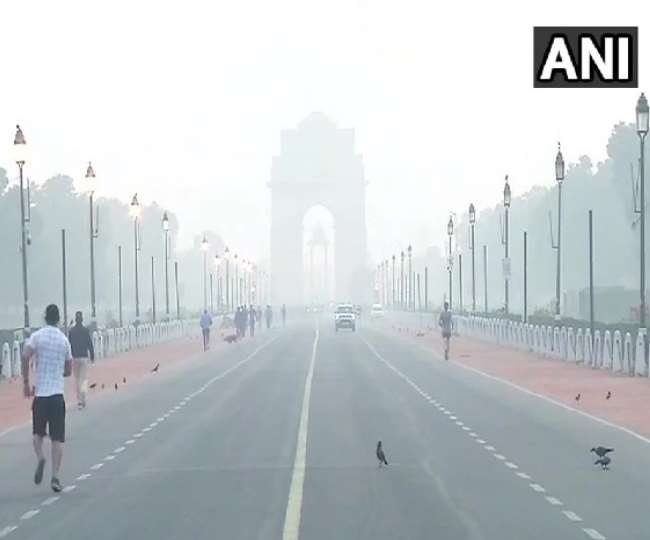
Stop pollution: Pollution increased by 18 percent in September, compared to last year

Pollution that disappeared during lockdown was engulfed as soon as it was unlocked. In fact, this time it is much deeper than the previous year. The state of September is frightening. While winter is yet to come. Experts who keep an eye on the movement of pollution are expressing concern. At the same time, it is suspected that the dangerous nexus of Koran, winter and pollution can increase the pace of deaths…. Jagran correspondent Shashank Shekhar Bhardwaj from Kanpur and Sanjeev Gupta report from Delhi .
Due to the lockdown, the air quality index of Delhi NCR and several states of North India had reached a better position, but the situation has been deteriorating rapidly since August. 38 cities of the country including Delhi are being constantly monitored. The average quantity of PM 2.5 has been found to increase by 15–18 percent. That is, the speed of pollution is much higher than in the previous year.
In September last year, the average amount of PM 2.5 in Delhi-NCR, where it was 40 micrograms per cubic meter, has gone up to 47 micrograms per cubic meter this year. The team of experts from IIT Kanpur is engaged in this work in collaboration with National Clean Air Mission and Central Pollution Control Board. Member of HOD and National Clean Air Mission of Civil Engineering Department of IIT, Prof. According to SN Tripathi, the burning of agricultural residues, especially the straw, is the most dangerous for the cities of Delhi-NCR and North India. Due to this, the effect of damaging gases in the atmosphere and the formation of a sheet of microscopic elements remains for several days. Which has started
At the same time, the smoke emanating from the vehicles is also worsening the situation. Due to this, the amount of sulfur dioxide, nitrogen dioxide and PM2.5 are polluting the atmosphere. Apart from cities like Delhi, Noida, Ghaziabad, Gurgaon, Sonipat, Muzaffarnagar, the condition of cities like Uttar Pradesh’s Kanpur, Lucknow, Aligarh, Varanasi, Prayagraj has been deteriorating since the lockdown ended. The 15 cities of Uttar Pradesh are among the most polluted cities in the country.
IIT experts examine the fire count in collaboration with NASA’s Moderate Resolution Imaging Electronometer (MODIS) Web, which reports on major fires burning in any city. It showed that the incidence of fire (burning of agricultural residues) in UP in 2020 (till June) has been less than a quarter as of 2019. July was also fine. But from the end of August it started increasing, which continued to grow. Madhya Pradesh has also seen a faster pace than last year and cases have also increased in Punjab.
Experts say that with the increase in density of micro particles PM 10, micro particles PM 2.5 and PM forest in the atmosphere, the amount of harmful gases and micro elements in the atmosphere will increase continuously in the atmosphere. In this situation, the number of deaths from corona can also increase significantly.
Actually, all activities started when unlocked. When the industrial units started moving, the number of vehicles on the roads became the same. Heaps of garbage and debris can also be seen. The dust has started flying due to no spraying of water on the roads.
Cases of stubble burning are increasing rapidly in northern India as well as in the border areas of Pakistan. Experts said that now the wind direction has turned northwest. In the next few days, this smoke will start increasing air pollution in other cities including Delhi-NCR.
According to the Union Ministry of Health and Family Welfare, 40 million people in the country are suffering from respiratory diseases. Not only this, the lungs of Indians are said to be weak by 30 percent. At the same time, Corona has also put life in jeopardy. In such a situation, pollution and winter can worsen the situation.
The estimated annual quantity of straws originating in India is around 600 million tonnes. Uttar Pradesh has the highest share in this. 17.9 percent of the total agricultural residue originates from here. This is followed by Maharashtra (10.52 percent), Punjab (8.15 percent) and Gujarat (6.4 percent). The brick-kiln industry is the second largest consumer of coal in India. It uses 60 million tonnes of coal annually. Generally, brick-kilns are located in places where stubble burning is most prevalent.
Environment Protection and Pollution Control Authority (EPCA) chairman Bhurelal said that the pollution has become even more challenging in the Corona period. A double month of corona infection and air pollution can also increase mortality. Our effort will be to keep pollution under control this year. There should not be any activity that causes poison to enter the air. In this regard, clear guidelines have been given to all agencies and state governments. Action plan has been sought from every department to fix accountability. In the second week of October, once again a meeting of top officials of all the states will be called and the next strategy will be made, discussing the situation at that time.



Average Rating